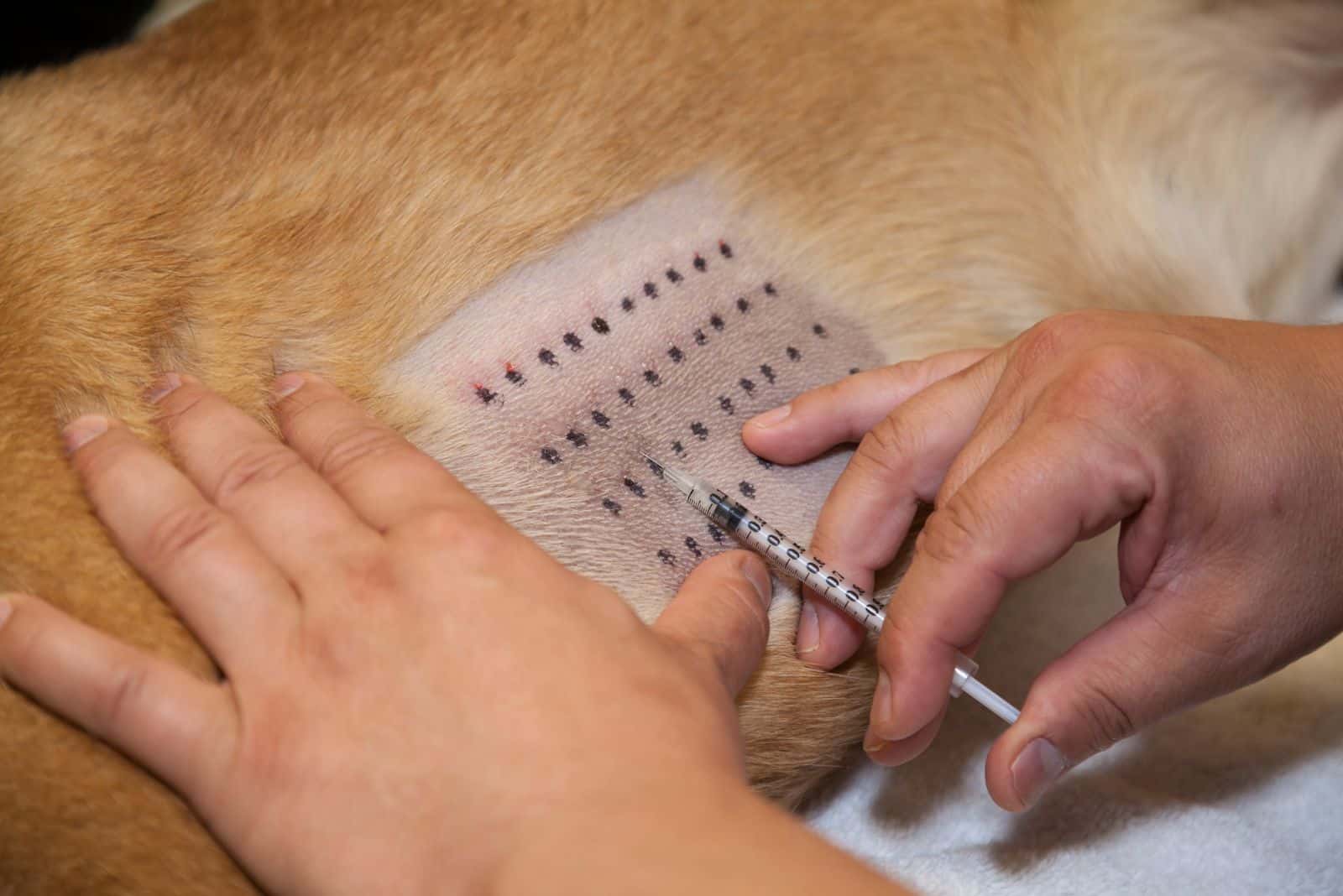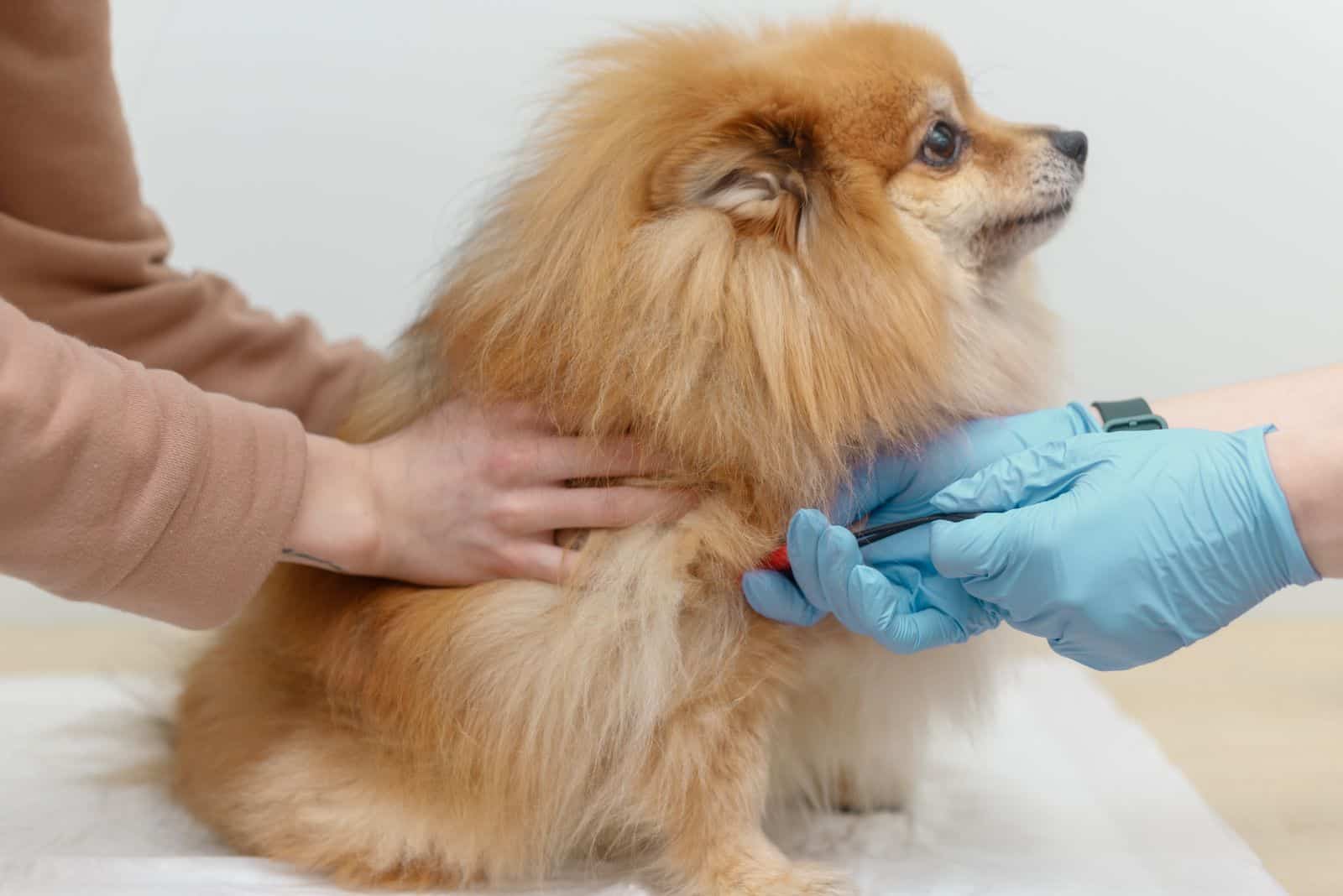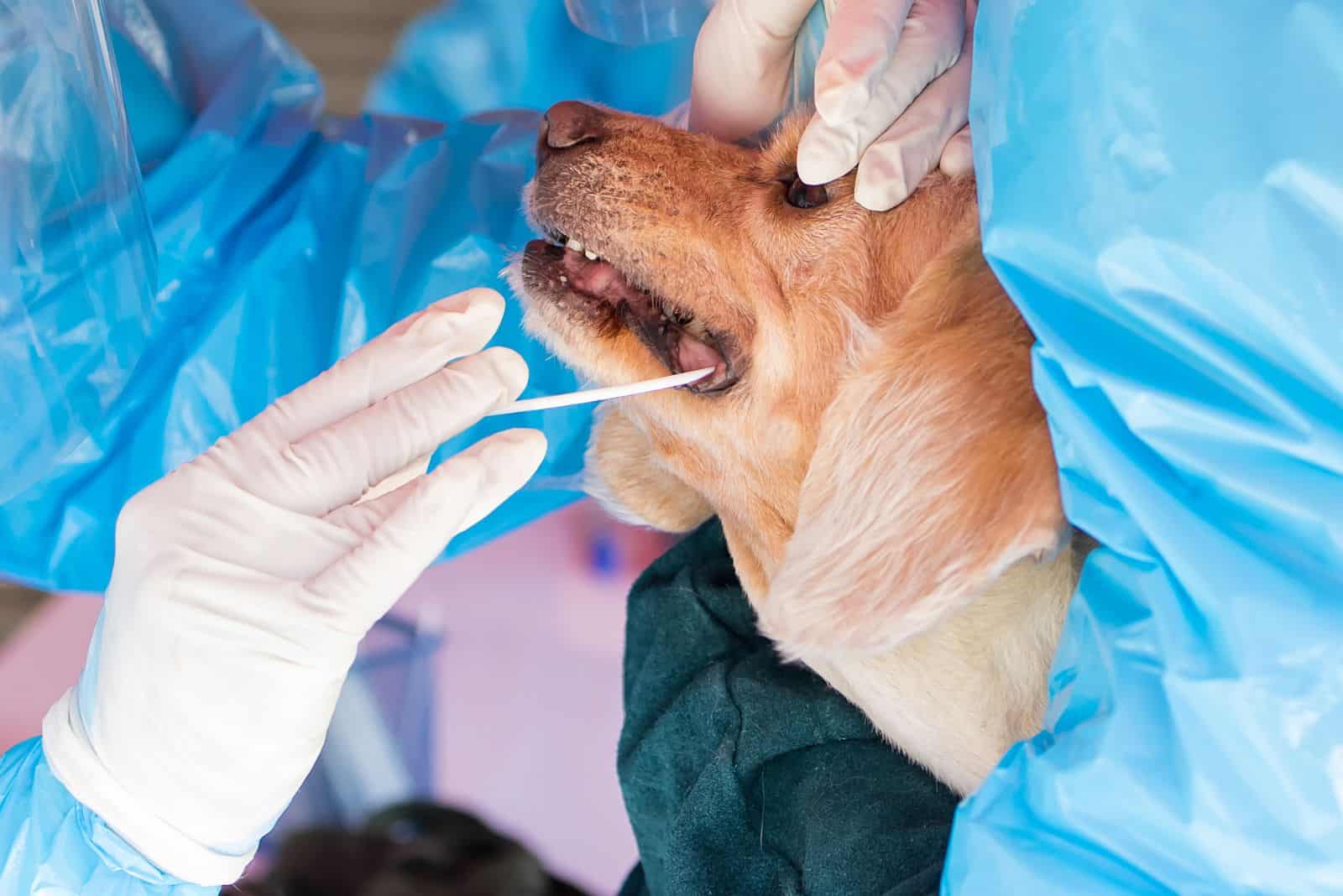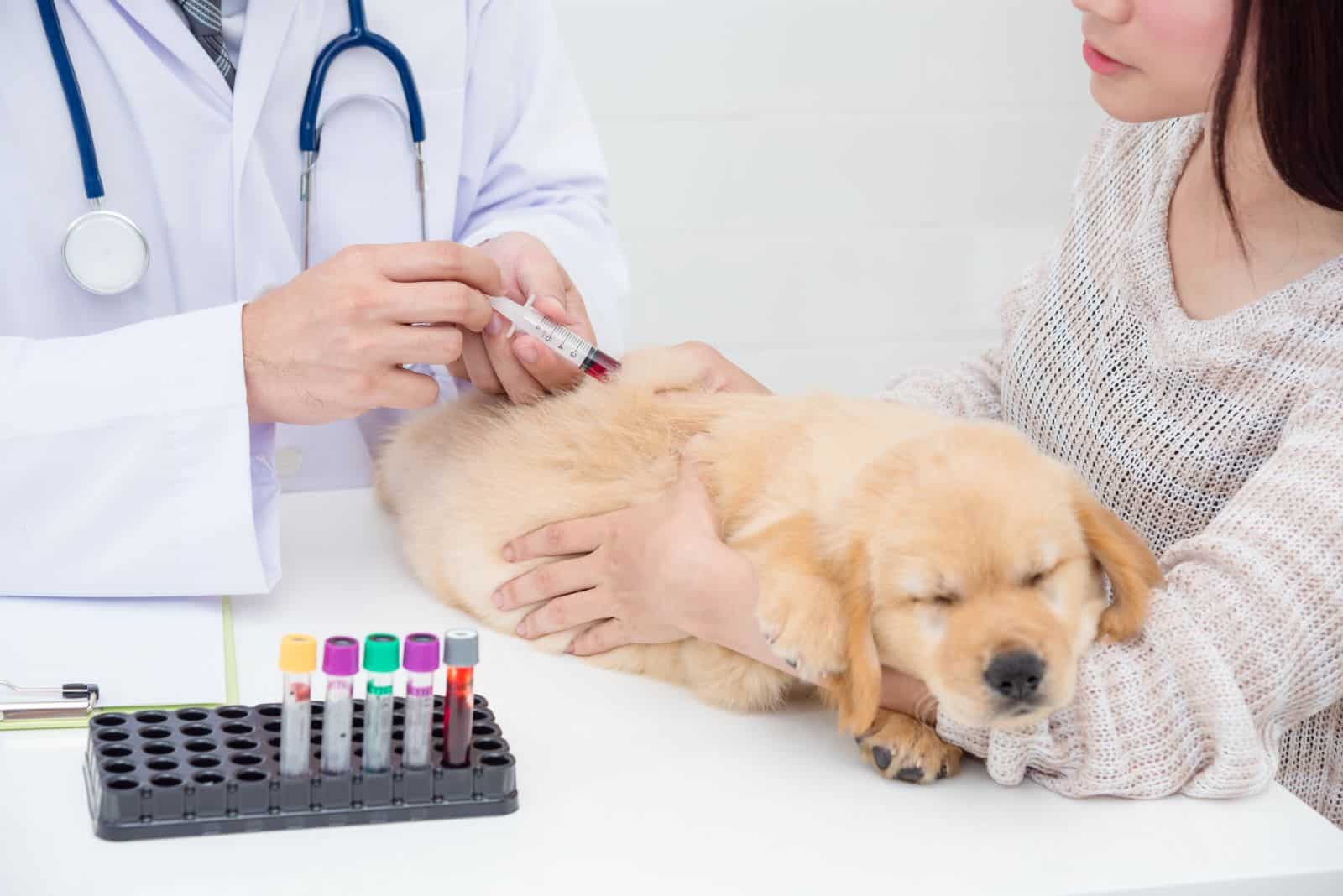Knowing every step of testing for allergies in dogs can be useful for pet parents who get a little bit nervous about vet visits. Let me tell you right now — allergy testing is not going to be a breeze, but it will not be traumatic, either.
The tests will definitely not be as comfortable and relaxing as lying on the couch, but you and your canine companion will make it through in no time. At least you will know what your dog is allergic to and fix it.
In any case, you will become more knowledgeable and relaxed about allergy tests after reading this, and at the same time, sort out those annoying itchy moments during food or playtime.
Types Of Dog Allergy Testing

Since you are probably reading this after noticing your dog scratching and nibbling its skin or being restless in general, you are planning to have your dog tested for allergies and want to know what to expect.
Put your mind at ease, the tests are quick, and your dog will hardly even remember them happening. They are performed by a veterinary dermatologist who specializes in matters of the skin.
You will have two options to choose from in terms of dog allergy testing — intradermal skin testing or allergen-specific IgE serological test (ASIS), also known as the radioallergosorbent test (RAST).
Intradermal skin testing is good for knowing the extent of your dog’s allergy to particular allergens. It is more stressful than the other two options due to the sedation and length of the test.
The RAST or blood test is very convenient and time efficient. However, some allergies have ambiguous results if only blood testing is done. Generally, veterinary dermatologists will perform both tests to cover all possible allergies.
Testing your dog for allergies at home is another option. It is affordable, convenient, and comprehensive. This method uses testing kits that allow any pet owner to easily “perform” the test and send it back for analysis.
Intradermal Skin Testing Your Pup
Known as the “gold standard” among veterinary dermatologists and the animal medical profession in general, this allergy testing method has proven to be the most revealing when it comes to environmental allergens.
Intradermal testing requires some preparation that involves stopping your dog’s therapy fourteen days prior to the test. Pets that are on an active corticosteroid or antihistamine treatment can have false negatives or positives in their testing, which is why their usage needs to be paused.
Another important thing to note is that your pet will need to be sedated. The process involves needles and pain at the injection sites, so preventing movement in the dog is a must. Do not worry, the sedatives will make it so that the dog feels no pain.
A good spot for this method is near the armpit, where there are fewer hairs on the dog’s body. If there are any patches of hair that obstruct a clear view of the skin, the dermatologist will remove them.
In case your dog’s allergic reactions are well-developed in that area, the dermatologist will pick another spot. Then, a line, circle, or any type of guideline will be drawn on the exposed skin for the purpose of separating and marking the individual allergen injections.
The allergen is injected into the outermost layer of the dog’s skin, the dermis. Since only a small dose of the allergen is injected, the reaction will cause the skin to become red and swell slightly.
This is completely normal since the immune system reacts immediately to allergen exposure by rushing antigens to the affected part of the skin. Measuring the swelling and the spread of redness will determine how allergic your dog is to a specific allergen.
What Kinds Of Allergens Are Used In Intradermal Skin Testing?
Most often, the allergens included in intradermal testing are environmental allergens. They include your run-of-the-mill culprits, such as different types of mold, dust and dust mites, pollen from all kinds of sources, etc.
Obviously, some of these, like dust and mites, are present throughout the year, so the chance of your dog showing sensitivity to that allergen will be greater. However, seasonal allergies caused by trees, flowers, grass, and other plants, can be a major problem with brachycephalic breeds.
Interpreting The Results And Cost
This segment of testing is easy with intradermal testing because the results are almost immediately visible. The injection spot for each antigen will either remain asymptomatic (no allergic reaction) or symptomatic (redness and swelling on the skin).
The severity of the reaction determines which allergens are causing the most harm to your dog’s body, so the treatment upon assembling all test results will be custom tailored for your pet. This can not only include medication but also changes to the dog’s diet.
Since a specialist performs these tests, the cost of intradermal skin testing is between seventy-five and two hundred dollars. The cost increases with dog size, so owners of smaller dog breeds will have a better time in terms of money spent.
A downside of intradermal testing for allergies in dogs is the fact that veterinary dermatologists are not widely available. Finding one can prove to be difficult, and prices might be higher than average.
Check out our article on the smallest dog breeds to save on allergy tests. You are welcome.
ASIS, RAST, Or Simply Blood Test

A blood test for your dog’s allergies is the least stressful way to obtain results. The sample collection can be done by a general veterinarian without the need for a veterinary dermatologist.
This means your dog will spend less time worrying about its life and more thinking about that new sweet potato treat recipe you have been talking about. Back to the allergy tests.
Radioallergosorbent tests are most commonly used for identifying the cause of atopic dermatitis (atopy) in a dog. Atopy is directly connected to seasonal allergies because the inhalation of allergens such as pollen can result in symptoms being displayed on the skin.
However, blood tests are used for detecting any type of allergy, including flea allergies and food allergies. There will be no anesthesia, hair shaving, or anticipatory stress, just a single blood sample taken by your vet that will then be sent to the laboratory for analysis.
This method is not the best at pinpointing the allergens and grading their level of severity but is a great tool for preparing a hyposensitization therapy treatment plan for dogs suffering from atopic dermatitis.
False positives occur more frequently in blood testing for allergies than in intradermal skin tests, which is why this method works best in conjunction with IDT. There is an advantage to blood testing for allergies in dogs because treatment does not need to be paused prior to the test.
What Does The Blood Test Look For?
An ASIS test aims to detect antibodies specifically connected with IgE (Immunoglobulin E). This kind of antibody is much less present in comparison with other antibodies, which makes the blood test efficient for detecting “true allergy”.
Known as free IgE receptors, these antibodies contain proteins that specialize in fighting various parasitic infections, giving them the ability to attack several types of foreign bodies found by the immune system.
On the other hand, IgE antibodies that work in connection with specific cellular receptors are present in the blood for longer and will react only to a cognate polyvalent allergen, that is, their counterpart.
This gives ASIS tests an advantage in detecting the allergen that the body is hypersensitive to. However, dust mites are the most commonly detected allergen by blood tests, and the ASIS test’s “favoritism” can hide the true suspects, i.e. environmental allergies.
Making Sense Of The Results And Pricing
Since this is a laboratory analysis, you will need to have your doctor of veterinary medicine (DVM) explain the results. The values associated with each IgE cellular receptor will show the number of antibodies that were activated to fight that specific allergen.
If the value is high, then your dog is hypersensitive to that allergen, and adequate treatment and lifestyle changes will need to be implemented. The cost of a blood test is between two and three hundred dollars. I guess you do pay for the convenience and fast results.
Are At-Home Allergy Testing Kits Useful?

The name itself screams convenience, and it is exactly what it does — it requires no driving with your pet to the DVM, waiting for the test to be done, and then spending the rest of the day waiting for your dog to shake off the anesthetic.
While there are many brands that produce these kits, their general reliability is still disputed. Research on these commercially available testing kits has shown that their specificity, sensitivity, and predictive values are not up to par for determining the cause of atopic dermatitis.
How Does An At-Home Testing Kit Work, And What Allergens Does It Detect?
Not every kit has the same collection method. Some will arrive with a saliva test collector, while others require only a hair from your dog’s body. You get a special tube container where you can secure the collected saliva or hair sample and send it off for analysis.
Expect to receive detailed results in four weeks, along with dietary recommendations from the company. Though the kit is advertised as an allergy test, it is closer to a sensitivity test.
The difference is that sensitivity tests focus on predictive values, or simply put, on potential allergies. Most of the product pages confirm that in the first paragraph, but the allergy test designation might be misleading.
Knowing your dog’s predisposition towards certain allergens is a good thing to know, but the “affordable” average price of over a hundred dollars is a bit disproportionate to what you get.
Boasting over one hundred allergens to test against, these kits aim for a grand entrance but, in the end, offer nothing concrete to help you manage the situation. Even on their websites, there is a disclaimer that a vet visit is recommended after receiving the results.
An Honest Opinion
If your dog already has flea, food, or skin allergies, you are better off spending around the same for an intradermal skin test or slightly more for a blood test. The results provided by either or both of these tests will be crucial for your veterinarian to customize your treatment or diet.
Stopping therapy for a heads-up type of test is counterproductive. If your dog has sensitivity or intolerance for, let us say, certain foods, it will more than likely show it faster than you get your results.
If you are looking for the best dog at-home allergy testing kit recommendation, I would say do it the right way and visit a DVM or veterinary dermatologist. Roughly a hundred dollars will give you results that are of little actual use but provide some awareness about your dog’s sensitivity.
What Are The Side Effects Of Allergy Testing For Dogs?
A large majority of dogs have no serious side effects after allergy tests. However, behavioral changes are possible, especially with intradermal skin testing.
Since the test revolves around poking your dog’s skin with allergens, swelling, redness, and itchy skin for a couple of hours after coming home are a possibility. The anesthetic wearing off can also have a limited impact on your dog’s activity level, lethargy or slowed movement can happen.
Understanding Dog Allergy Symptoms

Allergies are an odd bunch. While atopy is a chronic condition found in one in every ten dogs (making it relatively rare), food allergies are present among certain dog breeds.
Food allergies will have symptoms affecting the digestive tract, such as an upset stomach, vomiting, constipation, and diarrhea. It is not uncommon for a strong intolerance and sensitivity to some food ingredients to manifest as hair loss or itchy skin.
The majority of allergies have common symptoms, which means figuring it out yourself will be difficult. This is why a blood test can help diagnose allergies that have a common cause, and intradermal skin tests will provide insight into individual allergens and reaction severity.
Symptoms Of Atopic Dermatitis
Environmental factors such as dust mites, tree, grass, and weed pollen will usually have an immediate effect on your dog’s behavior and health.
If you see your dog sneezing, licking, and scratching or pawing its head after a walk, you are most likely looking at an inhalant allergic reaction. Your dog might exacerbate the symptoms by making the skin soft at the itchy spot, thus facilitating the entry of germs into the skin.
Though not a symptom of allergies, hives are often found in dogs with moderate sensitivity to allergens but not receiving treatment for it. For this reason, the veterinarian will, in most cases, do a full panel on bacterial, viral, and fungal infections to rule out non-allergy conditions.
Another “undercover” symptom of unmanaged allergic reactions is susceptibility to ear infections. With inhalant allergens, the time that it takes for ear infections to become more frequent is shorter because the particles are in direct contact with the airway.
Keep in mind that allergy tests on their own are not a sure way to confirm an atopic dermatitis diagnosis. After excluding underlying conditions as causes for allergy-like symptoms, an assessment of the clinical picture leads to a final conclusion.
While removing allergens from the dog’s environment is impossible in this case, the best thing is to have a vet perform tests for conclusive results. This will make it possible to create the best treatment plan, including allergy medication.
Topical treatments work well for reducing itchy skin but do little to inhibit the allergens from wreaking havoc. Oral medications like corticosteroids and antihistamines are crucial in keeping allergies at bay, so the vet might prescribe Prednisolone or Benadryl for moderate allergies.
As a precautionary measure, your dog might receive an antibiotic or antifungal therapy due to allergies weakening the immune system and increasing the chances of infection.
A Little More About Atopy
Atopic dermatitis is a skin disease caused by allergies. Atopy, however, is when the top layer of the dog’s skin displays symptoms caused by inhalant allergens. You might find it a little bit confusing, but atopy is a sign of severe sensitivity to allergens.
This skin disease can be caused by flea or food allergies too, but inhalant environmental allergens are the most frequent cause of atopic dermatitis. Regardless of the cause, the itch is too strong for the dog to ignore, and secondary infections occur in a large majority of cases.
Blood tests will reveal the antibodies that are most active when there is an allergic reaction, allowing the vet to precisely target individual allergens.
The best treatment for most dogs is a combination of oral medications, medical shampoos, and topical treatment.
Life With A Dog With Atopic Dermatitis
Although we covered all the things related to testing for allergies in dogs, symptoms, and the most common allergic reactions themselves, you should know both your dog’s and your life will change in case of an atopic dermatitis diagnosis.
Managing the symptoms will include expensive medications (immunotherapy) that are often specifically created for your dog. The monthly cost of atopic dermatitis treatment can easily reach three hundred dollars.
Diet changes will be necessary for a dog with a continuously weakened immune system, as allergies can take a toll on your dog. Vet-approved and rigorously health-checked foods for these purposes can easily cost you two hundred dollars per month.
The treatment and diet can be adjusted if the condition improves. After several follow-up allergy tests, the vet will reassess the situation and recommend lowering medication dosages, adding or removing foods, etc.
A couple of things dogs with atopic dermatitis might benefit from are regular baths after walks in pollen-rich areas, regular grooming with a soft brush to avoid dirt accumulation, and indoor physical activity.
You might be good with the first two “extras”, but how do you exercise a Labrador Retriever (genetically predisposed to atopic dermatitis) indoors? Well, I did not mean inside the house. I meant something like a training facility.
This can be a great way to release frustration for the dog and owner. Some obedience or agility training will be beneficial to shift the focus from the itchy skin and boring treatment routines.
I mean, if you are dishing out hundreds of dollars on therapy, a couple hundred more on fun activities will make things more bearable.
How Do I Know If My Dog Has A Food Allergy

If your pup’s discomfort after eating is worrying you, then the dog-allergen relation could be established through food. Dog food can contain proteins that brachycephalic breeds are sensitive to. Animal meat protein is the most common ingredient containing these allergens.
Sensitivity or intolerance can develop due to prolonged exposure to allergens or be congenital. In either case, I would say food allergies are easy to diagnose but hard to successfully implement if your dog is allergic to several kinds of animal proteins.
The symptoms will be consistent with similar (previously ruled out) conditions and will include more frequent pooping, vomiting, diarrhea, bloat, excessive drooling, flatulence, etc. If you recently introduced some new protein like game meat to your dog’s diet, that could be a cause.
Vets diagnose it by starting your dog on an elimination diet. This is self-explanatory — possible allergen-bearing ingredients are removed from the diet until the dog shows improvement.
Commercial dog foods (especially cheap ones) can contain allergens, so switching brands or upping the quality of the product will not help your dog. A food trial set by your vet usually takes around eight weeks.
The omission of animal protein means you will have to use supplements to make up for the nutrients contained in the meat and organs. You will work with your veterinarian to find the best solution for your dog’s wellness.
Following up on the elimination diet, you will need to ditch the “old ways” and focus on home-cooked meals that are based around chicken and soy protein, or go for a commercial food that has been specifically made for dogs with food allergies.
Hydrolyzed Diets Are Safe And Efficient
Home-cooked diets can be ineffective in treating food allergies because your dog might be allergic to the majority of available meat proteins. This is where hydrolyzed diet comes into play.
The process of hydrolysis is when the protein contained in meat and organs is broken down to such tiny particles that the immune system pays no attention to it. Such diets are also very useful in dogs who have inflammatory bowel disease.
Flea Allergies Are Pesky But Treatable
There is nothing worse than thinking about parasites biting on your best canine friend. As one of the main causes of allergic dermatitis in dogs, flea bites can be fatal if your dog has a sensitivity to the protein in the flea saliva.
Most often, the fleas will pack their bags and leave your dog’s coat after feeding on its blood. Still, the saliva can do serious damage to your dog’s body in a couple of seconds.
Flea allergies are particularly detrimental to the health of dogs that are immunocompromised due to other types of allergies or conditions that weaken the immune system. Luckily, both intradermal and blood tests can successfully help diagnose flea allergy dermatitis (FAD).
The most noticeable symptom is hair loss in the famous flea triangle (mid-back region up until the tail and down the hind legs). Red, itchy, and possibly painful patches of skin form at the localized points where the bites occurred.
Treating FAD consists of pest control, short-term corticosteroid medications, and antihistamines for long-term use. Corticosteroids can have side effects if used for a long period of time.
A high likelihood of developing diabetes mellitus, frequent urinary tract infections, degradation of coat quality, and reduced platelet production are some of the most serious and, unfortunately, common side effects.
For this reason, your veterinarian will instruct you to alternate and gradually reduce corticosteroid usage in treating flea allergy dermatitis. There are more effective and appropriate options than corticosteroids, so make sure to discuss them with your DVM.
Summary
It is ridiculous how far we have come from talking about testing for allergies in dogs. It is better to be informed than surprised by what happens, so I believe you will find comfort in knowing all about dog allergies.
For some of them, like flea allergies, prevention is possible by using anti-pest collars, drops, or other forms of parasite repellant. Regular shots and vet visits will drastically reduce the chances of FAD happening to your dog.
Food allergies require major adaptation periods and lifestyle changes but are otherwise well-covered in terms of alternatives to traditional feeding regimes. If your dog has food allergies, it might be a very mild case and a specific type of ingredient.
Atopic dermatitis and atopy are by far the most difficult to treat and manage, but where there is a will, there is a way. If you notice some of the symptoms mentioned in this article, make sure to call your vet and discuss your options.
As ever, take care, and I will write to you soon.
